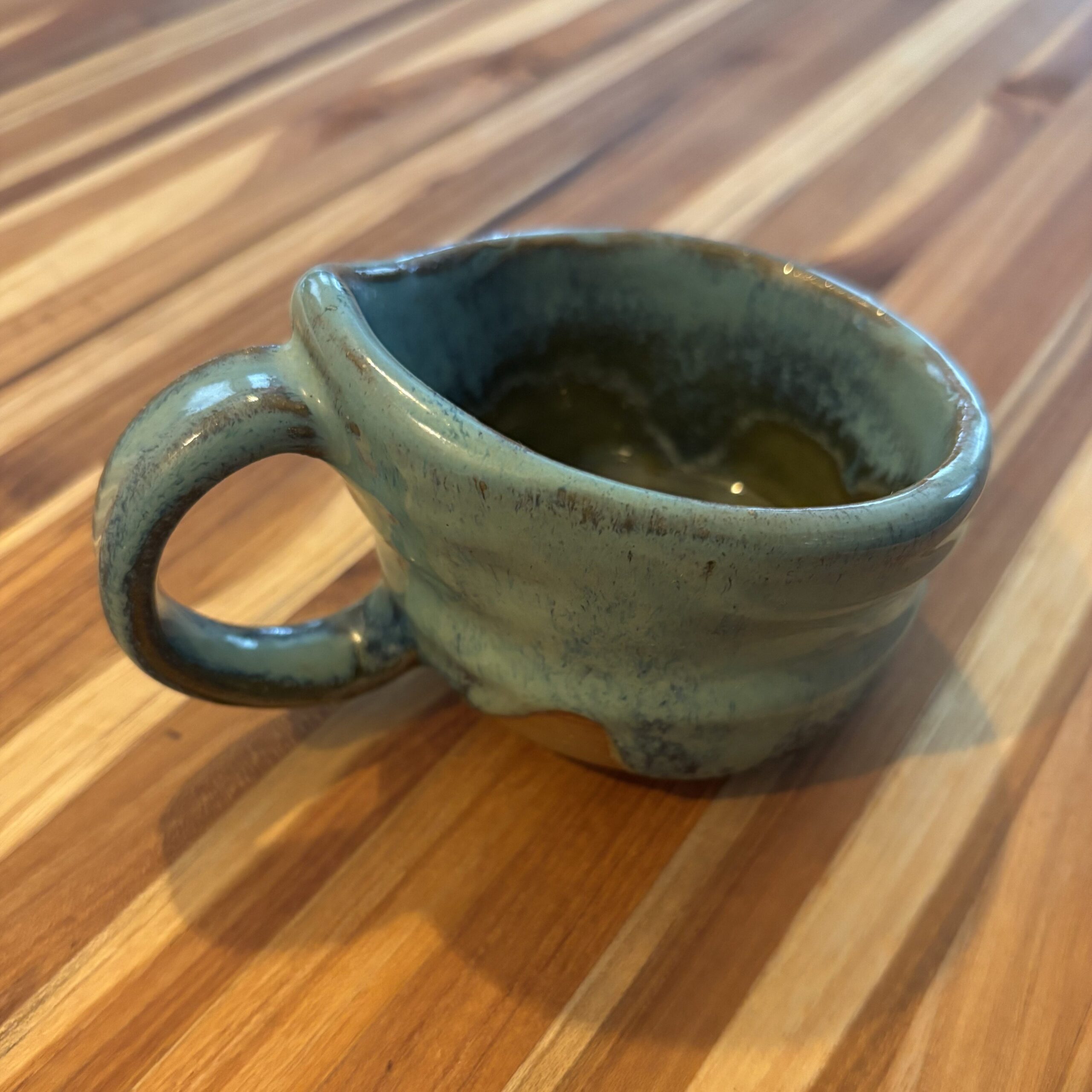This terrible mug I made supports a wonderful local nonprofit.

It isn’t a one-time donation or a grant. It’s a mug that’s kind of hard to drink from. To the nonprofit, it’s a vital form of support nonetheless.
According to Tim Sarrantonio, director of corporate brand at Neon One and chair of the Fundraising Effectiveness Project, this mug can represent something bigger: a framework for funders to think about all the different ways they can support nonprofits at a point in time where they really need it.

In our conversation earlier this month about the state of nonprofits and foundations in 2025 his core point was that there is a whole “world of generosity” funders can learn from and participate in. Taking a clay class from a local nonprofit in his area being one example.
For him and his nonprofit, it wasn’t a transaction. It was an interaction. An act of building a relationship which just so happened to also result in a nice little candle holder.

This example hit home for me, to the point where, throughout our conversation, “putting your hands in clay” became shorthand for use to articulate how funders can embrace a larger “world of generosity.” It also motivated me to go take a clay class myself.
To explore this “world of generosity” we first need to understand three of its fundamental truths: most nonprofits don’t have much money and what money they do have mostly comes from one-time gifts from individuals.
Get the 2025 funder data report
Read our report to learn how the nonprofit sector is meeting the moment.
Increasing payouts and reducing grantee burden
Nonprofits don’t have much money. Right now, consider increasing your payouts and work to reduce grantee burden every chance you get.
What’s happening right now
Tim lays it out:
- 97% of nonprofits have under $5 million
- 90% have under $1 million
- 82% have under $250 thousand dollars
This is a potentially precarious position to be in even without disruptions like federal funding freezes. The Urban Institute has a data tool that visualizes the financial risk of nonprofits losing government grants, which our friends at Candid used to identify that “Two-thirds of nonprofits receiving government grants would face deficits if these grants disappeared.”
All of this leads to a simple conclusion: nonprofits need money. Now.
Some foundations have answered the call and raised their funding caps. The MacArthur Foundation made waves by increasing its funding cap by 1%, from 5% to 6%, and encouraging others to do the same. Rapid response grants are also on the rise, with the Skoll Foundation, for instance, committing $25M to help compensate for the near dissolution of US international aid.
This is a great start, but if you’re hearing a desire in your organization to do more, you’re not alone. Reporters at the Chronicle of Philanthropy said they’re hearing that foundation leaders want to pull back and look at the long term while foundation employees want to address the immediate needs of nonprofits.
Tim speaks to this tension, “It’s a reductive answer to just tell foundations to pay out more money. But what it means is that we need to plan for the future. We need to have a futurist lens that the change we want to see happen will not happen potentially in our lifetime. But we can’t wait for the market conditions to be right to get the ball rolling.”
He continues by pointing out that now is not the time for more walls between communities and the resources they need: “We [as a sector] keep designing solutions and data tracking and applications and program impact analyses that are so over-engineered that the vast majority of people will be walled off from it for the simple fact that they don’t want to click past the first stage of the application.”
This has long been a point of contention. As Kari Aanestad mentions in her Impact Audio episode, “20% to 30% of a grant writer’s full-time work is being lost on technical time wasters.” Make sure that, when you increase your funding, you’re also reducing grantee burden.
One of the best ways to start reducing grantee burden is to get out from behind a form and speak with nonprofits. Be human, put yourself in their shoes, and understand their pain points. “Touch clay,” as Tim might say. Here are a few strategies.
Considerations for reducing grantee burden
Kari Aanestad has a few practical tips for reducing grantee burden in her Impact Audio podcast episode. Here’s a free #FixTheForm checklist you can use and our companion blog post if you want to dive deeper.
- Match the amount of time to apply to the amount of the award. Kari says, “We don’t want to spend 20 hours of our time pursuing $1,000 of funding.”
- If possible, provide a view of the entire application process from the get-go.
- Don’t ask for data you’ve already collected (e.g., demographic data) or that you can get on your own (e.g., mission statements).
Our advice is to fill out your application yourself from scratch to identify opportunities like the above examples and more.
What we can work towards together: Creating long-term change by increasing funding now.
Tim’s final thoughts on increasing funding for nonprofits: “At the end of the day, most of these folks don’t have any money. They don’t have any resources. How can we support them? We’re not asking that, we’re asking ‘We need to figure out how you’re relevant to us.’”
Supporting roles that build relationships with individual donors
Most charitable donations come from individuals. As a funder, now is a good time to support roles at nonprofits that interact with individual donors.
What’s happening right now
In the US, 67% of charitable giving comes from individuals according to the Giving Institute’s study on 2023 giving behavior. These donations are in decline. According to the most recent Fundraising Effectiveness Project Q4 2024 Report, “Donor numbers have dropped by -4.5% year-over-year, with smaller donors ($1-$100) showing the sharpest decline at -8.8%.”
Individual donors can provide nonprofits with firm ground to stand on. At a time when nonprofits are dealing with a ton of change, to say the least, solid footing on this firm ground is invaluable. But what happens when this ground starts to shift?
It increases pressure when nonprofits really don’t need it. Donor data is one example. When talking about managing donor data, Tim says, “Anyone with a credit card or a dollar can become an individual philanthropist for a nonprofit. That’s cool! That means everybody can get involved. But, how do you focus?”
Data literacy, Tim says. And not just for big wig fundraising and development roles. As he puts it, “We need to empower all fundraisers—not just people with CFREs after their name—to know how to use data.”
As a funder, supporting roles that interact with donor data, like development teams, could have a big impact right now. And supporting data literacy across the sector could help long-term.
Beyond data literacy, supporting development roles at nonprofits can make a big difference right now by giving them the resources to maintain donor relationships at a vital time. In his recent article for SSIR, Armando Zumaya, executive director of Somos El Poder, says, “A side effect of nonprofits becoming accustomed to large foundation grants is that they do not develop diverse fundraising streams, and as a result—in moments of crisis—find themselves without experienced development teams, whose years of working to build relationships would now be crucial.”
Individual donors are foundational to nonprofit resilience. The roles that develop relationships with individual donors need help, whether it’s with practical details like ensuring the cleanliness of donor data or larger trends like development teams not receiving support from funders.
Understanding how you, as a funder, can help requires you to roll up your sleeves and get to work. Work to understand the day-to-day needs of these nonprofit teams. Here are a few tactics to consider.
Considerations for building relationships with individual donors
Zumaya’s article has a few great practical steps you can take, so we recommend you give it a read. The pieces of advice that stood out are:
- Fund professional development (like data literacy, as Tim suggests).
- Endow fundraising positions.
- Don’t sideline fundraisers in “capacity building” funding.
What we can work towards together: Providing relief to this “front line” of nonprofit workers who interact with individual donors.
Tim’s final thought on funders’ relationship with individual donors: “What are you doing to make it easier to connect to the everyday donor?”
How the Jerome Foundation is helping nonprofits weather the storm
Read our interview with Eleanor Savage, president and CEO of the Jerome Foundation, to see the actions their taking to support their community.
Turning one-time donors into recurring givers
Most individual donors only give once. Turning these one-time donations into recurring gifts is a huge opportunity that can have an outsized impact on nonprofit resiliency this year. To do this, look to help nonprofits create a sense of belonging in their donors.
What’s happening right now
Most donors only give once, and that is true even for some of the most dedicated supporters, like volunteers. According to Tim, “Only two out of ten new donors support a nonprofit beyond their first donation,” and “only 3.3% of recurring donors are also tagged as a volunteer.”
The number of repeat donors is also on the decline. The Fundraising Effectiveness Project Q4 2024 Report states: “Retention rates declined by -2.6% year-over-year. While retention rates have fallen across all donor size segments, the sharpest declines seen amongst the Micro and Small donor groups. November and December of 2024 intensified this decline in the rate of donor retention, signaling ongoing struggles in re-engaging both first-time and repeat donors.”
Some strategies are proven to encourage these one-time donors to become recurring donors. One of the strongest, Tim points out, is events. He says that, during events, “Percentages of recurring giving jumps up to the 30s-40s%.” He continues,
“It’s very clear that one of the strongest things that everyday philanthropists are doing is, they’re attending events. They’re attending community gatherings. Our research doesn’t look at whether they’re galas – at least a third of the types of things people are doing have nothing to do with an auction item. Like, I go to clay class and I do ceramics. I have a little ceramic piece that I made with my own hands and watched come alive. And I’m buying that course from my client because they’re in my local community. That is the vast majority of what people are doing now. And funders can go – they can experience these programs. Live amongst the people. Go put your hands in clay. ”
Another common tactic is creating a donor club. Abby Jarvis, director of content at Neon One, says “Helping someone feel like they are part of an in-group or part of a club or a society … is really important, especially if they’re getting more relevant regular updates on what is actually going on.”
The reason why these strategies work is because they create a sense of belonging among donors. According to Neon One, based on analyzing notes from donors to nonprofits, people give based on their identities, aligning with one of five categories, including love (love for the work or people involved/impacted), inspiration (being inspired), and remembrance (in memoriam for loved ones).
These are all very personal reasons. Neon One says “For many, their decision to give is a deeply
personal one—one that’s tied to their very identity.” When you tie their act of giving to a transformative experience, like an event, or an ongoing commitment, like a donor club, it can become a part of who they are. It’ll help make them feel a sense of belonging.
And they know this innately. Tim summarizes: “The vast majority of people out there are not just giving money, they’re volunteering, attending events, and being advocates. That’s the larger world of generosity.” As a funder, consider what you can do right now to help facilitate these acts of generosity, whether it’s donating space for an event or helping to promote clay class.
Considerations for creating a sense of belonging
Belonging can increase the rates of recurring donations. However, creating that sense of belonging requires deep knowledge of the donor and their motivations for giving. Start by asking your nonprofit partners what they need to build this relationship with donors. They may come with answers like:
- Donating space for events.
- Helping create and promote community-centric events (e.g. clay class) and consider participating in these events.
- Getting involved in or helping to facilitate donor clubs.
What we can work towards together: Help create a sense of belonging which is proven to improve the rates of recurring gifts.
Tim’s final thoughts on creating a sense of belonging: “Funders should feel enthusiastic and excited that there’s much more happening than just the money. And how are they helping that thrive? How are they giving space to that? They have resources that nonprofits don’t. How can we 10x it by simply thinking: ‘OK I’m going to give you a gathering space.’”
“If we weren’t designed to solve big problems together, we’d be dead.”
In our conversation, Tim brought up The Dawn of Everything by David Graeber and David Wengrow (a book I had just started reading a few days before our conversation). Once he did, much of what he was advocating for clicked into place for me.
Graeber and Wengrow argue that human beings do not naturally interact with each other in a cold, transactional way – to give and to take. In fact, archeological and historical evidence seems to indicate that most civilizations operated with a form of reciprocal generosity.
There is, of course, a lot of nuance to this idea (I mean, it’s a whole book – go read it), but Tim summarized it this way:
“Humans want to be free. They want to put their hands in clay. They want to talk over dinner. And they want to figure out big problems. If we weren’t designed to solve big problems together we’d be dead. We’d be extinct a long time ago. We’re soft, we’re frail as humans. We’re really weak when we get down to it compared to a rhinoceros or an elephant. We have reasoning and we have thinking. This stuff is the basics. And, in many ways, our sector is on the front of innovation because what we’re doing is figuring out how generosity can get us back to that humanity.”
There’s a lot of change happening right now. What the next four years will look like is, well, anyone’s guess.
But here’s one comfort: there’s a big world of generosity out there. And we’re in it together.
Talk to your nonprofits. Give more than just money. Be human. Touch clay. This is how we can change things for the better in the long term.
Get the 2025 funder data report
Read our report to learn how the nonprofit sector is meeting the moment.